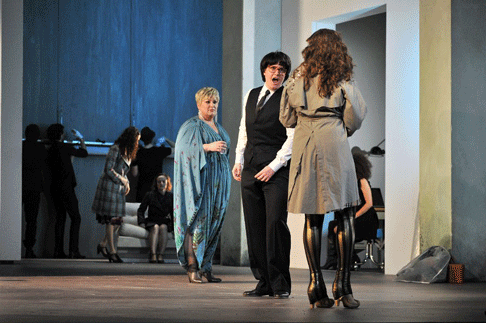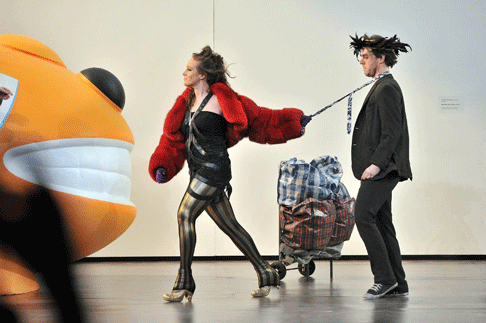06 Mar 2011
Ariadne auf Naxos, Bordeaux
Ariadne on Naxos, or you could call it Bacchus á Bordeaux. It was an orgy of art.

Ariadne on Naxos, or you could call it Bacchus á Bordeaux. It was an orgy of art.
The opera’s prologue got us pretty concerned about exactly how the Strauss/von Hofmannsthal conceit (superimposing improvised comedy on high art tragedy) would play out. It was going to happen in some sort of distressed art space where some pretty bad art (a huge, plastic sculpture) had been lifted out to make space for more, we assumed, bad art (“performance art” is at least naughty if not usually bad).
But all this turned out to be a high flying artistic extravaganza. Its riches were three fold — first it is a big opera with three great roles for sopranos, second there were three great sopranos, and third Bordeaux gave the opera a mise en scène that played with its complexities and reveled in its fun.
Performance art is as close as we come these days to commedia dell’arte, so this transcription of art form was well taken, plus performance art seems to question the nature of art more than it questions anything else and this led metteur en scène Roy Rallo to probe the depths of this silly Strauss/von Hofmannsthal tragedia cum commedia and to find out that it is in fact a fairly serious artistic treatise.
The ubiquitous wreck of a cheap sofa that inhabits most performance spaces here headquartered Najade, Dryade and Echo in various prone positions while stage hands poured buckets of dirt over them, Ariadne was seated in the neon tube outlined sand box, with the remnant, a small head (remember the huge sculpture in the prologue), of a dog’s toy that was the minotaur, and Theseus too. Echo outlined the minotaur head on the ubiquitous performance space white wall during Ariadne’s lament, and later seconded the forceful horn announcements of Bacchus’ arrival with determined throws of her yoyo. More dirt was poured on Najade and Dryade.
When it was Zerbinetta’s turn in the sand box she sang her ravishing parody in nightclub garb only to be sexually ravaged by the comedians (painting her in lurid colors). When she became Harlequin’s wife in an American gothic tableau during Ariadne’s prayer we understood all too well that all this was the trappings of ordinary, everyday mortal love in contrast to the grandiose ideal of love sought by Ariadne.
Well, Bacchus arrived and we had Orpheus and Euridice all over again. In reverse. When their gaze finally met it was all over, Bacchus disappeared into the void (all the doors onto the stage burst open — out the back we even saw the building across the street) and Ariadne was left alone on the stage as the beat-up Zerbinetta with her sad Harlequin husband exited through a side door into a snow storm.
So, all this was art, but what about life? That was of course Strauss’ Composer who had a bitter artistic pill to swallow, though this young composer thought he had found a soul mate in Zerbinetta, and he poured his heart out about it, only to be first of the opera’s lovers to learn that true love is not to be had in this life. Just then there was a bonus: the Opéra National de Bordeaux enriched Strauss’ ridiculous concoction by superimposing an operatic whim of its own — real time, curtain calls onto the prologue!
 Heidi Melton as Ariadne, Elza van den Heever as The Composer and Brenda Rae as Zerbinetta
Heidi Melton as Ariadne, Elza van den Heever as The Composer and Brenda Rae as Zerbinetta
Marsha Ginsberg gave detailed design to the sets, the dirty walls and chipped tiles of a very realistic building blurring the boundaries between art and real life, and costumer Doey Lüethi further complicated this distinction with real clothing that sometimes screamed character. Lighting by Chris Akerlind cannily intermixed the real and the arty, the flashing red and green lights during the opera’s final sublime love music reminding us that all this was, said and done, performance art confusing itself with art.
Yes, it took the considerable artistry of three exquisite sopranos to pull this off. Elza van den Heever (Composer), Heidi Melton (Ariadne) and Brenda Rae (Zerbinetta) are new generation artists with beautiful, fresh and well-schooled voices that illuminate amazing histrionic depth with elegant artistry. Mlle. van den Heever literally tore up the stage in her aria. Not to mention that Zerbinetta tore up the stage as well, standing motionless for her aria, and Heidi Melton brought real gravity to the opera’s opera, sitting with her back against the wall, her legs splayed downstage, her voice lofting torrents of gorgeous tone.
 Brenda Rae as Zerbinetta and Thomas Dolié as Harlequin
Brenda Rae as Zerbinetta and Thomas Dolié as Harlequin
Conductor Kwamé Ryan drove the big moments of the opera to maximum Straussian effect, and that effect was considerable indeed, though precision and energy were wanting in the detail that Strauss lavishes on his musical story telling. This was most noticeable in the Prologue, though it is possible that this Prologue’s laxity was also the result of the heavy-handed exposition of the performance art metaphor.
The Harlequin, sung by baritone Thomas Dolié, created the evening’s most touching moments, approaching Ariadne’s sandbox with his arms outstretched during her lament, and then as Zerbinetta’s forlorn husband. The Music Master was confidently portrayed by Oliver Zwarg. Actor Martin C. Turba as the Major-domo seemed to be at odds with the musical and staging rhythms of the Prologue further deadening it. Tenor Arnold Bezuyen as Bacchus confused bellowing with singing. Najade (Mélody Loulejian), Dryade (Leslie Davis) and particularly Echo (Eve-Christophe-Fontana) brought fine singing and much pleasurable deadpan perspective to Ariadne’s suffering.
Michael Milenski